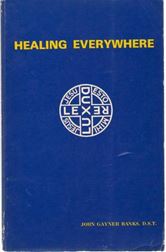Order of St. Luke International 2019: From an Anti-Cessationism past to a Fully Charismatic Future

One of John G. Banks’ most influential books.
The OSL grew slowly but steadily in the decades from the 1930s. Some churches with OSL chapters established weekly or monthly healing services, other parishes did not have official chapters but continued healing services after hosting one of the Rev. Bank’s healing missions. This is routine stuff for most of us, but in the 1930s to 1950s these healing services was revolutionary and controversial in view of the lock that cessationism had on the thinking of orthodox Christians. Pastors who hosted them were sometimes snubbed and ridiculed by their colleagues as becoming cultic. Sharing magazine regularly posted on its last page the names of doctors, professors and other professionals in an attempt to show that it’s believe in healing prayer was truly respectable, and not something that only the “crazy” Pentecostals did. That had little effect.
After World War II (1945), progress came more quickly. For instance, St. Stephen’s Episcopal Church in Philadelphia, which had a very active OSL chapter, became national centers of healing prayer and hosted a yearly healing summit and conference on Christian healing. These conferences attracted the leadership and members of the OSL and other (non-Pentecostal) Christian healing groups such as the Life Abundant ministry.
Of course, the Pentecostals were doing great healing work at the same time, but they were marginalized as “fanatics” and “heretics” during the pre-World War II period, as well as after. They did not much influence the mainline churches, or the OSL, until the Charismatic Renewal of the 1960s.
The Holy Spirit had a different agenda and His gifts rolled …
The OSL was inter-denominational from its inceptions, although it was majority Episcopal well until the 1970s, when Methodist and other mainline Christians increasingly added to its roles. Interestingly, the last three “wardens” of the national OSL have been non-Episcopalian or Anglican. (No, OSL members are not locked up. “Warden” in the UK has a broad meaning of someone in charge of a group.)
When the Charismatic Renewal broke out in the 1960s there existed a large network of OSL chapters with regional boundaries, a national headquarters and elected leadership. One would imagine that the OSL would welcome the Renewal. But in fact just the opposite happened.[6]
Category: Church History, Summer 2019


